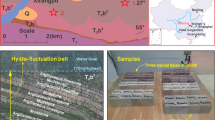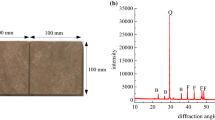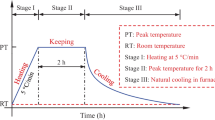Abstract
This study addresses the crack evolution law and shear behavior of weak muddy intercalations (WMIs) during wetting-drying cycles. The original crack images of WMI were processed; adjustments were made to overcome the reflective differences of crack on the surface of the WMI samples caused by the uneven surface and impurities, effectively distinguishing the crack and non-crack areas in the images of the WMI sample surface. In addition, the total length, average width, area ratio, and number of cracks were extracted as the index represents the crack condition of the WMI sample surface. Shear testing on surface of the WMI sample was used to analyze the shear properties for different wetting-drying cycles, and the relationships between crack propagation and shear properties in the wetting-drying cycles were considered. The results show that the wetting-drying cycles elongate crack on the surface of the WMI sample. The average widths of the cracks also increase, and a large number of new tensile cracks are generated. As a result, the crack degree increases with the wetting-drying cycles. Crack propagation could also weaken the WMI structure as the development of the crack may reduce the tight contact points between WMI particles, leading to decreased cohesion in the WMI. As for the shear behavior of the WMI, the shear strength may decline with the wetting-drying cycles but tends to stabilize after a certain number of cycles.




















Similar content being viewed by others
References
Cao L (2007) Experimental study on strength characteristics of dry-slip cycle of Qianjiangping landslide in Xiaer area. Geotechnical (s 1):93–97
Chen J, Dai F, Xu L, Chen S, Wang P, Long W et al (2014) Properties and microstructure of a natural slip zone in loose deposits of red beds, southwestern China. Eng Geol 183:53–64
Cheng Q (2009) Study on Shear Creep Properties of Weak Interlayers of Typical Red Layer Soft Rocks. J Rock Mech Eng 28(S I):3176–3180
Cui KR, Guo-Feng LI (2013) Influence of drying and wetting cycle on strength characteristics of expansive soil in Ma’anshan road in Hefei. J Geol
Hu RL, Lee CF (2001) Mechanical behaviour and microstructural variation of loess under dynamic compaction. Eng Geol 59(3–4):203–217
Huang Z, Chen W (2016) Study on the relationship between expansion and shrinkage of improved expansive soil and shear strength. Hydrogeol Eng Geol 43(3):87–93
Huang M, Wang H, Sheng D, Liu Y (2013) Rotational–translational mechanism for the upper bound stability analysis of slopes with weak interlayer. Comput Geotech 53(13):133–141
Khanlari G, Abdilor Y (2015) Influence of wet–dry, freeze–thaw, and heat–cool cycles on the physical and mechanical properties of upper red sandstones in Central Iran. Bull Eng Geol Environ 74(4):1287–1300
Li YR, Wen BP, Aydin A, Ju NP (2013) Ring shear tests on slip zone soils of three giant landslides in the Three Gorges Project Area. Eng Geol 154(2):106–115
Li W, Liu GS, Yao T (2014a) Improvement of methods for crack image processing and crack feature extraction of expansive soil. Rock Soil Mech 35(12):3619–3626
Li Y, Liu W, Yang C, Daemen JJK (2014b) Experimental investigation of mechanical behavior of bedded rock salt containing inclined interlayer. Int J Rock Mech Min Sci 69(3):39–49
Liu C (2008) Analysis method of fracture parameters of rock and soil based on digital image recognition. Geotech Eng 30(9):1383–1388
Liu RX (2016) Study on the effect of acid dry-wet cycle on the deterioration of strength characteristics of argillaceous sandstone. J Rock Mech Eng 35(8):1543–1554
Liu C, Tang CS, Shi B, Suo WB (2013) Automatic quantification of crack patterns by image processing ☆. Comput Geosci 57(4):77–80
Liu X, Jin M, Li D, Zhang L (2017a) Strength deterioration of a shaly sandstone under dry–wet cycles: a case study from the Three Gorges Reservoir in China. Bull Eng Geol Environ (S3):1–15
Liu X, Wang Z, Fu Y (2017b) Strength and failure criterion of argillaceous sandstone based on dry-wet cycle. Rock Soil Mech 38(12):1–7
Mamtani MA, Vishnu CS, Basu A (2012) Quantification of microcrack anisotropy in quartzite — a comparison between experimentally undeformed and deformed samples. J Geol Soc India 80(2):153–166
Nowamooz H, Masrouri (2010) Influence of suction cycles on the soil fabric of compacted swelling soil. Compt Rendus Geosci 432(12):901–910
Otsu N (1979) A threshold selection method from gray-level histograms. IEEE Trans Syst Man Cybern 9(1):62–66
Quesada D, Picard D, Putot C, Leguillon D (2009) The role of the interbed thickness on the step-over fracture under overburden pressure. Int J Rock Mech Min Sci 46(2):281–288
Ren J (2002) Ct real-time testing on meso-mechanism of creep damage propagation in rock under uniaxial compression. J Hydraul Eng 33(1):10–15
Shit PK, Bhunia GS, Maiti R (2015) Soil crack morphology analysis using image processing techniques. Model Earth Syst Environ 1(4):1–7
Wang YC, Chen J (2013) Preliminary research on the relationship between microscopic structure and shear strength of red-bed soft rocks. Geoscience 27(3):738–742
Wang C, Zhang ZY, Liu Y, Fan SM (2017) Geometric and fractal analysis of dynamic cracking patterns subjected to wetting-drying cycles. Soil Tillage Res 170:1–13
Xiao YJ, Lee CF, Wang SX (2000) Spatial distribution of inter-layer shear zones at Gaobazhou dam site, Qingjiang river, China. Eng Geol 55(4):227–239
Xu DP, Feng XT, Cui YJ (2012) A simple shear strength model for interlayer shear weakness zone. Eng Geol 147–148(15):114–123
Ye WM, Wan M, C B (2011) Micro-structural behaviors of densely compacted GMZO1bentonite under drying/wetting cycles. Chin J Geotech Eng 33(8):1173–1177
Yesiller N, Miller CJ, Inci G, Yaldo K (2000) Desiccation and cracking behavior of three compacted landfill liner soils. Eng Geol 57(1–2):105–121
Yuan JP, Yin ZZ (2004) Quantitative index of crack and strength characteristics of crackd expansive soils. J Hydraul Eng (6):108–113
Yuan Z, Ni W, Tang C (2017) Experimental study of structure strength and strength attenuation of loess under wetting-drying cycle. Rock Soil Mech 38(7):1894–1902, 1942
Zai LU, Chen Z, Yi PU (2002) Study on damage crack propagation of natural expansive soil with computerized tomography during triaxial shear test. J Hydraul Eng 33(6):106–112
Zhang J, Gong B, Hu B (2011) Study of evolution law of fissures of expansive clay under wetting-drying cycles. Rock Soil Mech 32(9):2729–2734
Zhao NF, Ye WM, Chen YG, Chen B, Cui YJ (2017) Investigation on swelling-shrinkage behavior of unsaturated compacted GMZ bentonite on wetting-drying cycles. Bull Eng Geol Environ:1–11
Zhou X, Burbey TJ (2014) Deformation characteristics of a clayey interbed during fluid injection. Eng Geol 183:185–192
Zhou CY, Mu CM (2005) Relationship between micro-structural characters of fracture surface and strength of soft clay. Chin J Geotech Eng 27(10):1136–1141
Zuo C, Liu D, Ding S, Chen J (2016) Micro-characteristics of strength reduction of tuff residual soil with different moisture. KSCE J Civ Eng 20(2):639–646
Acknowledgments
The work was supported by the National Natural Science Foundation of China (Grant No. 51574201) and the State Key Laboratory of Geohazard Prevention and Geoenvironment Protection (Chengdu University of Technology) (Grant No. KLGP2015K006). Additional support was provided by the Scientific and Technical Youth Innovation Group (Southwest Petroleum University) (Grant No. 2015CXTD05).
Author information
Authors and Affiliations
Corresponding author
Rights and permissions
About this article
Cite this article
He, L.P., Yu, J.Y., Hu, Q.J. et al. Study on crack propagation and shear behavior of weak muddy intercalations submitted to wetting-drying cycles. Bull Eng Geol Environ 79, 4873–4889 (2020). https://doi.org/10.1007/s10064-020-01842-7
Received:
Accepted:
Published:
Issue Date:
DOI: https://doi.org/10.1007/s10064-020-01842-7




